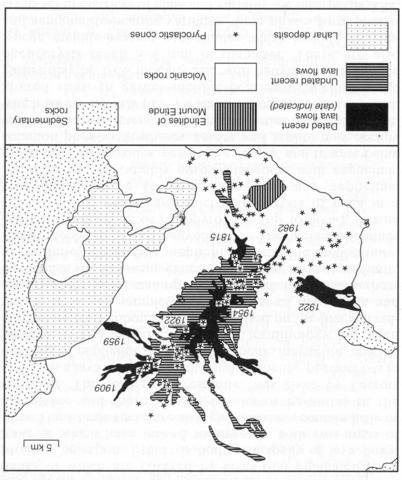stripes
Mount Cameroon rises from the sea coast along its southern margin to the 4095 m summit of Fako and is the highest mountain in West Africa. It is an active volcano located on a northeast-trending horst to which the steep northwestern and southeastern slopes of the volcanic edifice are probably related (Deruelle et al., 1987a). No basement rocks are exposed within the confines of the volcano and no basement xenoliths have been found so far, which led Deruelle et al. (1987a) to suggest that the total horst structure comprises volcanic rocks. Mount Etinde is a distinct volcano which is located on the lower southeastern slopes of Mount Cameroon, and this centre is described separately (No. 32). Overlying Cretaceous and Tertiary sedimentary rocks Mount Cameroon is elliptical in plan with dimensions of about 50x35 km at the base. There are over 140 pyroclastic cones which are abundant on parts of the flanks of the volcano and in the surrounding lowland areas. The plain of Tombel, between Mount Cameroon and Manengouba, is dotted with many cinder cones and explosion craters a number of which are occupied by lakes (Fitton, 1987). Mount Cameroon is a composite volcano built principally of lavas with a little pyroclastic material. Lavas sampled by Deruelle et al. (1987a) came mainly from the southwestern, southern and southeastern flanks and summit area and consist of picrite, alkali basalt, hawaiite and mugearite, all but two being nepheline normative. The picrites comprise abundant olivine phenocrysts in a groundmass of augite, magnetite and plagioclase. In the basalts augite phenocrysts are more abundant than olivine and rare hypersthene phenocrysts rimmed by augite have been identified, while plagioclase and magnetite may also form phenocrysts. In the hawaiites plagioclase phenocrysts (An60-85) become predominant and in the mugearites the plagioclase is An 50-55; apatite, phlogopite and alkali feldspar occur in the groundmass. Lavas with amphibole and nosean phenocrysts have been described and there are early reports of phonolite and trachyte. Major and trace element data for rocks are given by Deruelle et al. (1987a), who also present analyses of a range of minerals, and basalt analyses are in Sato et al. (1990). Rb-Sr, Sm-Nd, U, Pb and O isotopic data for two basalts are given by Halliday et al. (1988), and Hf, Sr, Nd and Pb isotope data on three further samples by Ballentine et al. (1997). The mineral and rock chemistry of two spinel lherzolite xenoliths from Lake Baronbi near Mount Cameroon are discussed in detail by Lee et al. (1996).Mount Cameroon erupted in 1982 when a basanitic (11 wt % ne) flow (Fitton et al., 1983) extended down the southwestern flank (Deruélle et al., 1983). It was also active in 1999 when a 7 km long flow developed on the southeast side. A review of the known activity of the mountain will be found in Gèze (1943) and a summary in Deruelle et al. (1987a).
BALLENTINE, C.J., LEE, D.-C. and HALLIDAY, A.N. 1997. Hafnium isotopic studies of the Cameroon line and new HIMU paradoxes. Chemical Geology, 139: 111-24.DÉRUELLE, B., MOREAU, C. and NSIFA, N.E. 1983. Sur la récente éruption du Mont Cameroun (16 octobre-12 novembre 1982). Comptes Rendus des Séances de L’Académie des Sciences. Paris, Ser. 2. 296: 807-12.DERUELLE, B., N'NI, J. and KAMBOU, R. 1987a. Mount Cameroon: an active volcano of the Cameroon line. Journal of African Earth Sciences, 6: 197-214.FITTON, J.G. 1987. The Cameroon line, West Africa: a comparison between oceanic and continental alkaline volcanism. In J.G. Fitton and B.G.J. Upton (eds), Alkaline igneous rocks. 273-91. Geological Society of London Special Publication 30.FITTON, J.G., KILBURN, C.R.J., THIRLWELL, M.F. and HUGHES, D.J. 1983. 1982 eruption of Mount Cameroon, West Africa. Nature. London, 306: 327-32.GÈZE, B. 1943. Géographie physique et géologie du Cameroun occidental. Mémoires du Muséum National d'Histoire Naturelle. Paris, N.S. 17: 1-271.HALLIDAY, A.N., DICKIN, A.P., FALLICK, A.E. and FITTON, J.G. 1988. Mantle dynamics: a Nd, Sr, Pb and O isotopic study of the Cameroon Line volcanic chain. Journal of Petrology, 29: 181-211.LEE, D.-C., HALLIDAY, A.N., DAVIES, G.R., ESSENE, E.J., FITTON, J.G. and TEMDJIM, R. 1996. Melt enrichment of shallow depleted mantle: a detailed petrological, trace element and isotopic study of mantle-derived xenoliths and megacrysts from the Cameroon Line. Journal of Petrology, 37: 415-41.SATO, H., ARAMAKI, S., KUSAKABE, M., HIRABAYASHI, J.-I., SANO, Y., NOJIRI, Y and TCHOUA, F. 1990. Geochemical difference of basalts between polygenetic and monogenetic volcanoes in the central part of the Cameroon volcanic line. Geochemical Journal, 24: 357-70.VINCENT, P.M. 1971. New data about Cameroon Mountain volcano. Journal of the Geological Society. London, 127: 414-5.

